Starting in December of 2015, I plan to begin experimentation with early period (Viking/Anglo Saxon) bronze casting. The plan is to use a clay/adobe style hand-made furnace of the sort used in Riba, Birka & Haithabu. This will entail a bit of work to make the furnace, then to set up a proper bellows system, make the crucibles, and then to finally get the furnace up to 2000 degrees (or so). This is the easy part!
After that comes the creation of the actual metal to be used. While it is easy to say “Bronze,” and think of a specific modern metal alloy, the reality is that modern bronze, which consists largely of copper and tin, was not the bronze used in any part of Medieval Europe (early or late).
ABOUT THE METAL
Tin, while used at fairly high levels by the Romans due to their extensive trading networks with Asia, was harder to come by in Medieval Europe. Small mines in Cornwall, Brittany and in the mountains of Spain produced limited amounts of tin, which were then used for government purposes (cannons, for instance), tools, and by the noble classes for higher-end jewelry made of tin-copper alloys such as pewter, brass and “bronze.”
Due to the limitations on quantities of tin to the public, mass-produced items consisted of a mixture of zinc, a very little bit of tin and mostly copper. According to Anders Sölderberg, this was the most common consistency of metal in archeological finds between 500-900 CE. In addition, Pare’s analysis of the metallurgy of 520 Bronze-Age graves North of the Alps, “roughly 200 had no tin at all, only 8% had more than 1% tin, and less than 5% had more than 4% tin.” Furthermore, according to Dungworth and Nicolas, by the 14th century, bronze was actually a leaded antinomy copper, often with little or no tin added at all! While leaded bronze would be fun to try out, I think sticking with a mixture of zinc and a little tin in a lot of copper would be healthier for experimentation than actually pouring pure lead in.
ABOUT THE MOULDS
Then comes the making of the moulds, which will be done in the manner outlined by Michele Hayeur Smith in her extraordinary experimental work: Breaking the Mould: A re-evaluation of Viking Age Mould-making Techniques for Oval Brooches, which is a chapter of a larger work referenced below. This process calls for making two part clay moulds off an original piece (a fascinating multi-step process), the application of linen inside the mould (have to see it to believe it), and the creation of the final piece. This requires a lot of time for making and firing the mould, and a mixture of quart-sand, peat, and fine clay.
Casting in clay moulds with the lost-wax method will be tried as well.
STEP ONE:
Well, step one is really reading a lot, but at some point the experimentation must begin! Therefore, a forge has been obtained for the purpose. Eventually, we (my wife and I) will attempt a more classic style of casting (a fire-pit with two bellows and layers of charcoal). Right now, something to contain the fire that could be used at my townhouse was needed, and therefore, we now have this amazing propane furnace, which melts the metal in about ten or so minutes:
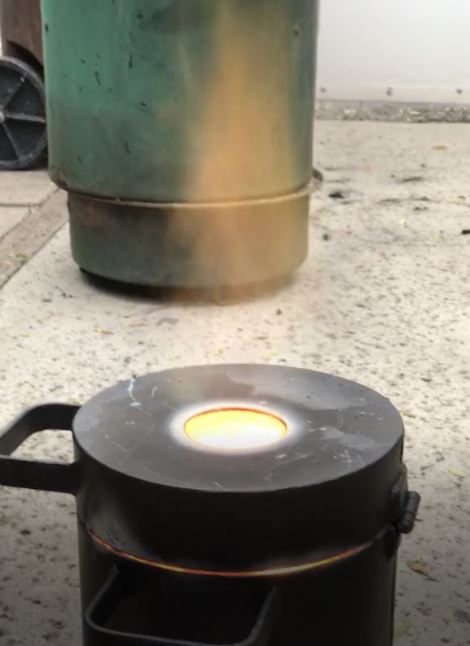
STEP TWO: MAKING the Alloy:
Viking Era metal casting involved a sort of brass over that of bronze (See research posted at the end). Therefore, both a zinc-based alloy for Viking-Era brass and tin, for classic bronze, will be attempted and cast.
Af far as the heating and melting of metal goes, Biringuccio recommends thusly:
“Then, in the name of God, begin to apply the fire, first putting the wood near the mouth of the entrance and then gradually, as the fire increases, proceed to push it forward up to the windows through which the flames enter the furnace. Take care, with the labors of one of your helpers, that this fire never slackens, but is ever continuous until your material is not only red or white, but tips up and begins to melt. Then force the flames with greater diligence until you find it wholly liquid and melted and ready to be poured easily into your moulds (295).”
Biringuccio goes further with a warning:
“Be on your guard, because long and powerful fires sometimes form a kind of skin on top* which retards the fire and prevents its vigor from penetrating. This is remedied by opening the furnace and breaking the skin by rubbing and striking a chestnut stick over it (296).”
*the skin presumably refers to the surface of the bronze in the pewter.
So now I have decided to order a chestnut stick from the UK (where they sell them for walking stick blanks). Might as well go period with what I can!!
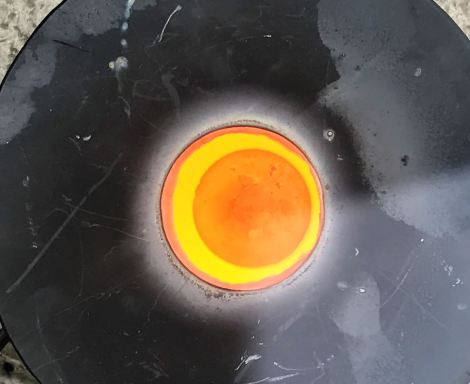
STEP THREE: MAKING THE MOULDS FOR BRONZE CASTING
The moulds for this project will be made in an early Scandinavian style, to which the experimentation of Michele Smith, published in De Re Metallica, will be immensely helpful. Her attempts at ‘Viking” era casting found their best results with a mould mixture of 40% clay, 40% sand, 20% peat (91).
The clay is the holding mixture, the sand is refractory for the heat, and the peat is necessary to provide a certain amount of sacrificial organic matter to carbonize when the high heat of the bronze is entering into the mould. The peat burns away and makes the mould porous enough to allow oxygen to escape, which is an important process if the mould to be filled all the way. As an aside, peat can, according to Biringuccio, be substituted by fine wool to achieve the same result.
These moulds will be two piece affairs, one for the front and one for the back. The model will be an already extant piece (made by me of pewter or a borrowed replica item, such as an oval brooch).
The steps followed will be exactly as laid out by Smith, which seems similar to the suggestion given at the Haithabu Museum (see the video below in the sources section):
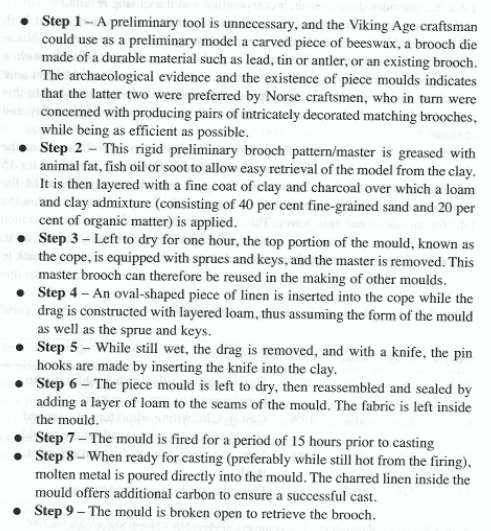
Step Two notes the use of fine clay and charcoal be applied before the mould mixture is applied. The main reason for this is to help retain the fine details in the front, or facing, mould. Smith did note that while her moulds were able to create copies of brooches, they did not retain decorative detail well without the fine clay layer. Interestingly, the Haithabu Museum video visually details out this layer of fine clay inside the face mould as well.
When mixing is complete, the moulds need to be heated up to 600-800 degrees for about four hours, to remove all moisture and to harden the mould. The heat is also required to make sure that the alloy does not clot upon entering during the pour due to hitting a cool surface. For my purposes, and for the Viking Era casters, a few hours with charcoal works quite well! Note that the below image is of the initial heating (it is good to start slow so as to not “shock” the clay mixture of the coal). Some of the moulds are surrounding wax masters, so the initial heating allows the wax to vaporize out. Eventually, the moulds will be placed inside of the charcoal mound:
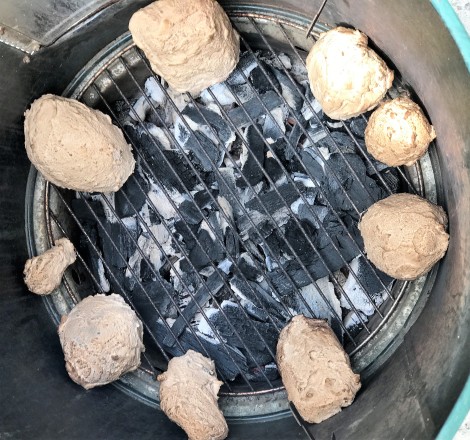
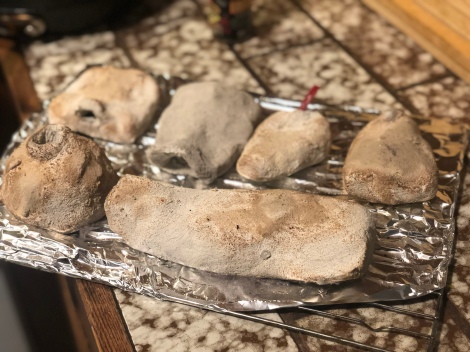
When the moulds are ready and the alloy is heated, it is time to carefully pour! Full body protection, from shoes to head, should be worn. If anything goes wrong, 2,000 metal is not a good thing to be wearing while hot. Never pour over cement (which always contains a little moisture), never go too quick, always reheat the metal between pours.
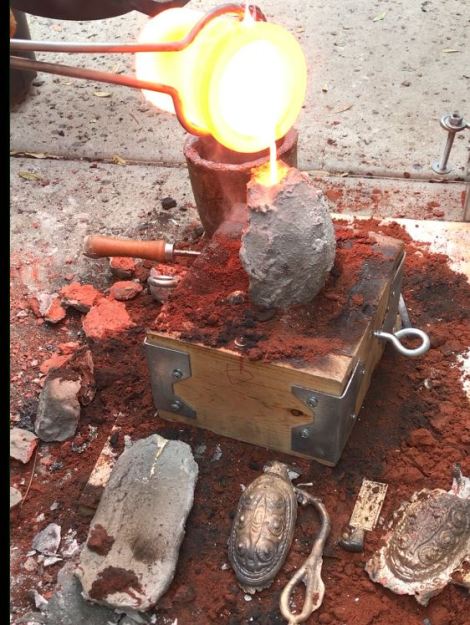
Some final pieces (the key is the only real finished piece, the oval brooches are practice runs and will eventually be melted back down for further attempts).

More recent casting projects, both from clay-matrix with direct mould and lost wax casting:
Wax casting Viking-Era keys and general wax casting (model inspiration seen in Denmark & Sweden):
As general tools and status symbols for women during the Viking Age (to have a key, one must have something to protect under a lock), I decided they would be cool to make for my wife. Here is my lost-wax casted attempt:
Wax tools for Viking keys, one box-brooch, a sword hanger, a trefoil and a luna
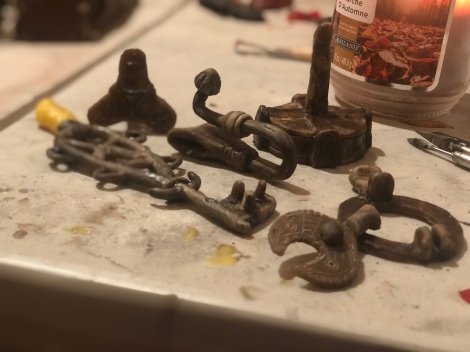
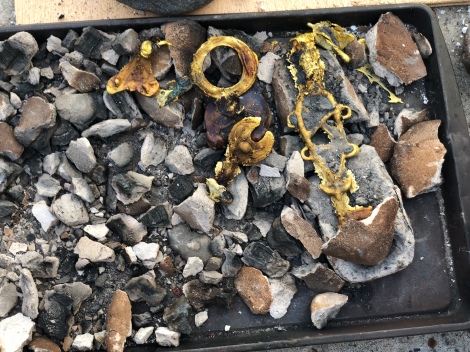
The wax has become brass, really. Now there is a TON of cleanup to do!
Viking Era brooches:
I loved the museum copy of the one on the left. So I made a few of my own style based off the major design elements of the extant piece:
Sword Hangars
So, my friend Bart keeps telling me that SCA folks need period sword hangars, but no one makes them. I went ahead an found a couple of pieces in the British Museum digital archives and am working on prototypes:
Here are two of my interpretations, one in bronze, the other in wax (awaiting casting). Also made sword-strap rings to rivet onto the sword straps. This would allow the sword and sheath to be removed as desired, but keeps the sword from falling off the belt through the use of overlay bits to help keep the strap ring from bouncing off. Note, these are very rough prototypes. Cleaned up copies will be made when the three SCA testers that I have weigh in!
Compilation of Research for this project:
References for this project consulted thus far:
Bencard, Mogens, ed. Ribe excavations 1970-76. Jutland Archaeological Society, 1984.
Bencard, Mogens, Lise Bender Jørgensen, Helge Brinch Madsen, and Aino Kann Rasmussen. Ribe excavations 1970-76. Jutland Archaeological Society, 2004.
Blair, John, and Nigel Ramsay. English Medieval Industries: Craftsmen, Techniques, Products. London: Hambledon Press, 1991.
Bork, Robert Odell. De Re Metallica: The Uses of Metal in the Middle Ages. Aldershot, Hants, England: Ashgate, 2005.
Dungworth, David, and Matthew Nicholas. “Caldarium? An Antimony Bronze Used for Medieval and Post-medieval Cast Domestic Vessels.” In Historical Metallurgy, 24-34. Vol. 38. Harmondsworth, Middlesex: Historical Metallurgy Society, 2004.
Gnudi, Martha Teach., Vannoccio Biringuccio, and Cyril Stanley. Smith. The Pirotechnia of Vannoccio Biringuccio: The Classic Sixteenth Century: Treatise on Metals and Metallurgy. Estados Unidos: Dover Publications, 1990.
Hedegaard, Ken R. ” Bronze molds Craft in Late Germanic and early Viking Age in Scandinavia.” Archäologie in Schleswig 2, 1992.
Lewis, G. R. The stannaries: a study of the medieval tin miners, by Lewis. Harvard University: D. Bradford Barton, 1908.
Meeks, Nigel, Caroline Tulp, and Anders Söderberg. “Precision lost wax casting.” Experimental and Educational aspects of Bronze Metallurgy, 2001.
Pare, C. F. E. Metals Make the World Go Round: The Supply and Circulation of Metals in Bronze Age Europe. Oxford: Oxbow, 2000.
Söderberg, Anders. “Scandinavian Iron Age and Early Medieval Ceramic Moulds – Lost Wax or Not or Both?” Scandinavian Iron Age and Early Medieval Ceramic Moulds – Lost Wax or Not or Both? | EXARC – Journal. 2013. Accessed January 21, 2017. http://journal.exarc.net/issue-2012-3/ea/scandinavian-iron-age-and-early-medieval-ceramic-moulds-lost-wax-or-not-or-both.
Söderberg, Anders. “Viking Metal Casting.” Viking Metal Casting. April 30, 1999. Accessed January 21, 2017. http://web.comhem.se/vikingbronze/casting.htm.











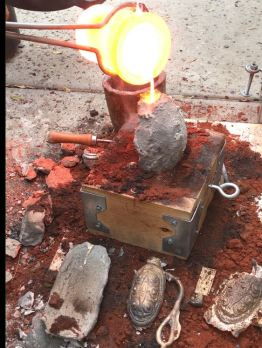
Leave a comment